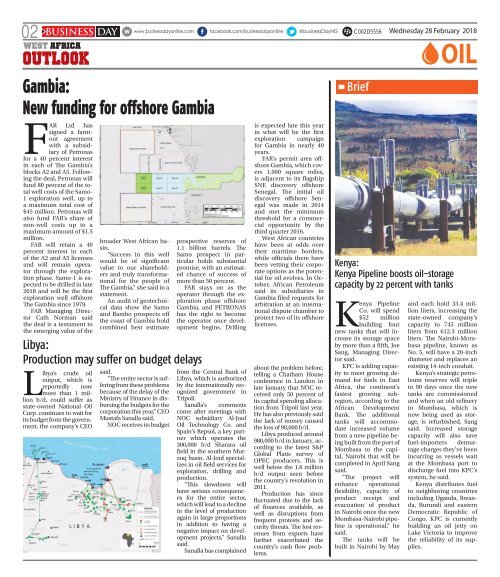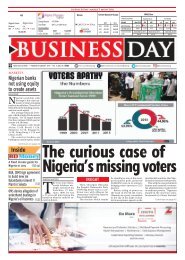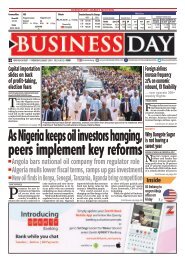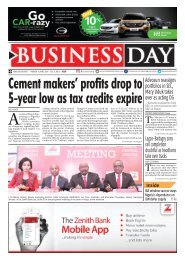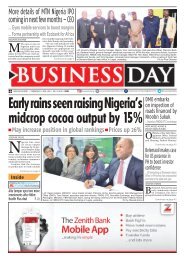BusinessDay 28 Feb 2018
Create successful ePaper yourself
Turn your PDF publications into a flip-book with our unique Google optimized e-Paper software.
Wednesday <strong>28</strong> <strong>Feb</strong>ruary <strong>2018</strong><br />
02 BUSINESS DAY<br />
C002D5556<br />
WEST AFRICA<br />
Outlook<br />
Gambia:<br />
New funding for offshore Gambia<br />
FAR Ltd has<br />
signed a farmout<br />
agreement<br />
with a subsidiary<br />
of Petronas<br />
for a 40 percent interest<br />
in each of The Gambia’s<br />
blocks A2 and A5. Following<br />
the deal, Petronas will<br />
fund 80 percent of the total<br />
well costs of the Samo-<br />
1 exploration well, up to<br />
a maximum total cost of<br />
$45 million. Petronas will<br />
also fund FAR’s share of<br />
non-well costs up to a<br />
maximum amount of $1.5<br />
million.<br />
FAR will retain a 40<br />
percent interest in each<br />
of the A2 and A5 licenses<br />
and will remain operator<br />
through the exploration<br />
phase. Samo-1 is expected<br />
to be drilled in late<br />
<strong>2018</strong> and will be the first<br />
exploration well offshore<br />
The Gambia since 1979.<br />
FAR Managing Director<br />
Cath Norman said<br />
the deal is a testament to<br />
the emerging value of the<br />
broader West African basin.<br />
“Success in this well<br />
would be of significant<br />
value to our shareholders<br />
and truly transformational<br />
for the people of<br />
The Gambia,” she said in a<br />
statement.<br />
An audit of geotechnical<br />
data show the Samo<br />
and Bambo prospects off<br />
the coast of Gambia hold<br />
combined best estimate<br />
Libya:<br />
Production may suffer on budget delays<br />
Libya’s crude oil<br />
output, which is<br />
reportedly now<br />
more than 1 million<br />
b/d, could suffer as<br />
state-owned National Oil<br />
Corp. continues to wait for<br />
its budget from the government,<br />
the company’s CEO<br />
said.<br />
“The entire sector is suffering<br />
from these problems<br />
because of the delay of the<br />
Ministry of Finance in disbursing<br />
the budgets for the<br />
corporation this year,” CEO<br />
Mustafa Sanalla said.<br />
NOC receives its budget<br />
prospective reserves of<br />
1.1 billion barrels. The<br />
Samo prospect in particular<br />
holds substantial<br />
promise, with an estimated<br />
chance of success of<br />
more than 50 percent.<br />
FAR stays on as the<br />
operator through the exploration<br />
phase offshore<br />
Gambia, and PETRONAS<br />
has the right to become<br />
the operator once development<br />
begins. Drilling<br />
from the Central Bank of<br />
Libya, which is authorized<br />
by the internationally recognized<br />
government in<br />
Tripoli.<br />
Sanalla’s comments<br />
come after meetings with<br />
NOC subsidiary Al-Jouf<br />
Oil Technology Co. and<br />
Spain’s Repsol, a key partner<br />
which operates the<br />
300,000 b/d Sharara oil<br />
field in the southern Murzuq<br />
basin. Al-Jouf specializes<br />
in oil field services for<br />
exploration, drilling and<br />
production.<br />
“This slowdown will<br />
have serious consequences<br />
for the entire sector,<br />
which will lead to a decline<br />
in the level of production<br />
again in large proportions<br />
in addition to having a<br />
negative impact on development<br />
projects,” Sanalla<br />
said.<br />
Sanalla has complained<br />
is expected late this year<br />
in what will be the first<br />
exploration campaign<br />
for Gambia in nearly 40<br />
years.<br />
FAR’s permit area offshore<br />
Gambia, which covers<br />
1,000 square miles,<br />
is adjacent to its flagship<br />
SNE discovery offshore<br />
Senegal. The initial oil<br />
discovery offshore Senegal<br />
was made in 2014<br />
and met the minimum<br />
threshold for a commercial<br />
opportunity by the<br />
third quarter 2016.<br />
West African countries<br />
have been at odds over<br />
their maritime borders,<br />
while officials there have<br />
been vetting their corporate<br />
options as the potential<br />
for oil evolves. In October,<br />
African Petroleum<br />
said its subsidiaries in<br />
Gambia filed requests for<br />
arbitration at an international<br />
dispute chamber to<br />
protect two of its offshore<br />
licenses.<br />
about the problem before,<br />
telling a Chatham House<br />
conference in London in<br />
late January that NOC received<br />
only 50 percent of<br />
its capital spending allocation<br />
from Tripoli last year.<br />
He has also previously said<br />
the lack of money caused<br />
the loss of 90,000 b/d.<br />
Libya produced around<br />
980,000 b/d in January, according<br />
to the latest S&P<br />
Global Platts survey of<br />
OPEC producers. This is<br />
well below the 1.6 million<br />
b/d output seen before<br />
the country’s revolution in<br />
2011.<br />
Production has since<br />
fluctuated due to the lack<br />
of finances available, as<br />
well as disruptions from<br />
frequent protests and security<br />
threats. The lost revenues<br />
from exports have<br />
further exacerbated the<br />
country’s cash flow problems.<br />
Brief<br />
Kenya:<br />
Kenya Pipeline boosts oil-storage<br />
capacity by 22 percent with tanks<br />
Kenya Pipeline<br />
Co. will spend<br />
$52 million<br />
building four<br />
new tanks that will increase<br />
its storage space<br />
by more than a fifth, Joe<br />
Sang, Managing Director<br />
said.<br />
KPC is adding capacity<br />
to meet growing demand<br />
for fuels in East<br />
Africa, the continent’s<br />
fastest growing subregion,<br />
according to the<br />
African Development<br />
Bank. The additional<br />
tanks will accommodate<br />
increased volume<br />
from a new pipeline being<br />
built from the port of<br />
Mombasa to the capital,<br />
Nairobi that will be<br />
completed in April Sang<br />
said.<br />
“The project will<br />
enhance operational<br />
flexibility, capacity of<br />
product receipt and<br />
evacuation of product<br />
in Nairobi once the new<br />
Mombasa-Nairobi pipeline<br />
is operational,” he<br />
said.<br />
The tanks will be<br />
built in Nairobi by May<br />
oil<br />
and each hold 33.4 million<br />
liters, increasing the<br />
state-owned company’s<br />
capacity to 745 million<br />
liters from 612.3 million<br />
liters. The Nairobi-Mombasa<br />
pipeline, known as<br />
No. 5, will have a 20-inch<br />
diameter and replaces an<br />
existing 14-inch conduit.<br />
Kenya’s strategic petroleum<br />
reserves will triple<br />
to 90 days once the new<br />
tanks are commissioned<br />
and when an old refinery<br />
in Mombasa, which is<br />
now being used as storage,<br />
is refurbished, Sang<br />
said. Increased storage<br />
capacity will also save<br />
fuel-importers demurrage<br />
charges they’ve been<br />
incurring as vessels wait<br />
at the Mombasa port to<br />
discharge fuel into KPC’s<br />
system, he said.<br />
Kenya distributes fuel<br />
to neighboring countries<br />
including Uganda, Rwanda,<br />
Burundi and eastern<br />
Democratic Republic of<br />
Congo. KPC is currently<br />
building an oil jetty on<br />
Lake Victoria to improve<br />
the reliability of its supplies.


